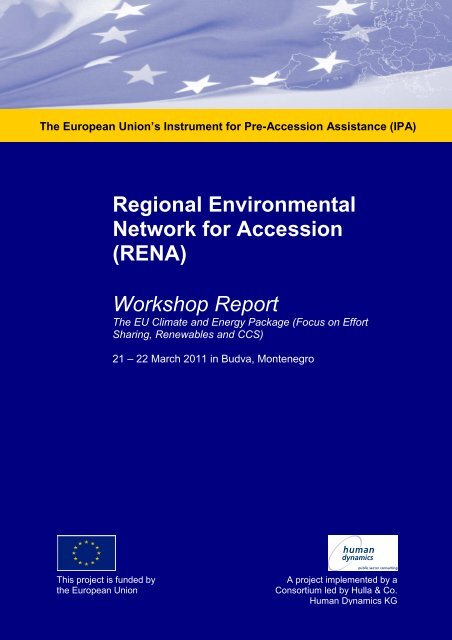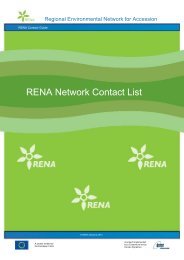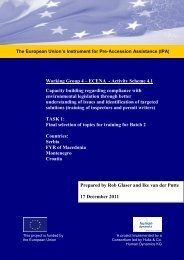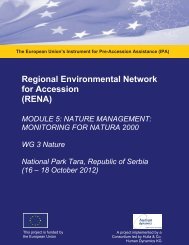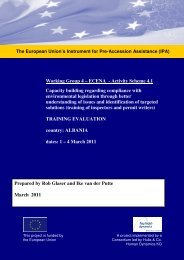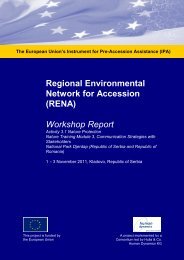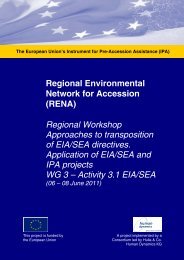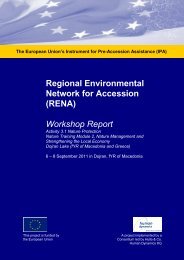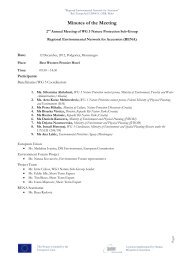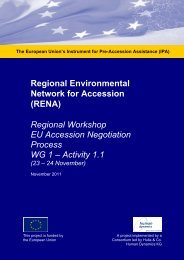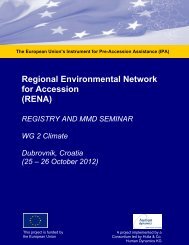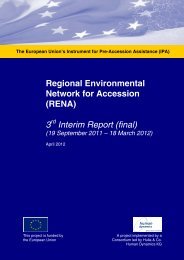Workshop Report March 2011 Budva ... - Renanetwork.org
Workshop Report March 2011 Budva ... - Renanetwork.org
Workshop Report March 2011 Budva ... - Renanetwork.org
- No tags were found...
Create successful ePaper yourself
Turn your PDF publications into a flip-book with our unique Google optimized e-Paper software.
The European Union’s Instrument for Pre-Accession Assistance (IPA)Regional EnvironmentalNetwork for Accession(RENA)<strong>Workshop</strong> <strong>Report</strong>The EU Climate and Energy Package (Focus on EffortSharing, Renewables and CCS)21 – 22 <strong>March</strong> <strong>2011</strong> in <strong>Budva</strong>, MontenegroThis project is funded bythe European UnionA project implemented by aConsortium led by Hulla & Co.Human Dynamics KG
The EU Climate and Energy Package (Focus on Effort Sharing, Renewables and CCS)21 – 22 <strong>March</strong> <strong>2011</strong>, <strong>Budva</strong>, MontenegroTable of contents1. The EU Climate Policy explained................................................................................................................. 11.1 Global warming ...................................................................................................................................... 11.2 EU Climate Legislation ......................................................................................................................... 11.3 Climate and Energy Package................................................................................................................ 21.4 Emission Trading System (EU ETS) Directive.................................................................................. 31.5 Effort Sharing.......................................................................................................................................... 41.6 Renewables.............................................................................................................................................. 51.7 Directive on geological storage of CO 2 ................................................................................................ 61.8 Energy Efficiency Plan .......................................................................................................................... 61.9 The 2050 Roadmap................................................................................................................................. 62. The <strong>Workshop</strong> ( 21 – 22 <strong>March</strong>) .................................................................................................................... 72.1 General..................................................................................................................................................... 72.2 Proceedings 21 <strong>March</strong> <strong>2011</strong>.................................................................................................................... 82.3 Proceedings 22 <strong>March</strong> <strong>2011</strong>.................................................................................................................... 92.4 <strong>Workshop</strong> conclusions ......................................................................................................................... 102.5 Evaluation of the workshop................................................................................................................. 11Annex 1: Participants....................................................................................................................................... 13Annex 2: Agenda.............................................................................................................................................. 16Annex 3: List of climate legislation (DG Climate Action and other DGs).................................................... 19Annex 4: <strong>Workshop</strong> Sheets under separate cover (www.renanetwork.<strong>org</strong>) ..................................................24Annex 5: Evaluation of the training ................................................................................................................26Page<strong>Report</strong> prepared by:Imre CsikósTeam Leader Climate Component (Working Group 2)Team Leader Cross Border Nature Component (Working Group 3 – Nature)Tel: +31 30 234 02 21Mob: +31 6 222 37 882Fax: +31 84 745 11 93e-mail: imre@renanetwork.<strong>org</strong>skype: imre.csikosThis project is funded by the European Union.RENA Secretariat: Hulla & Co. Human Dynamics KG; Lothringer Strasse 16, 1030 Vienna (Wien), AustriaTel: +43 1 402 50 21 12; Fax: +43 1 402 50 20 20; email: rena.secretariat@renanetwork.<strong>org</strong>Website: www.renanetwork.<strong>org</strong>
<strong>Workshop</strong> <strong>Report</strong> on the EU Climate and Energy package (Focus on Effort Sharing, Renewables and CCS1. The EU Climate Policy explained1.1 Global warmingThe first consequences of climate change can already be seen in Europe and worldwide, and these impacts arepredicted to intensify in the coming decades. Temperatures are rising, rainfall patterns are shifting, glaciers aremelting, sea levels are getting higher and extreme weather resulting in hazards such as floods and droughts isbecoming more common.These changes pose a serious threat to human lives, to economic development and to the natural world onwhich much of our prosperity dependsAccording to a recent <strong>Report</strong> of the European Environmental Agency, it is expected that the Western Balkansand Turkey will be hit especially hard. Forecast models predict reduced precipitation in an already water stressedregion (-22% in 2020, and -37% in 2070), higher temperatures (especially in summer, affecting a possible declinein summer tourism which is one of the most prominent economic sector in the region), an increase in extremeevents (heat waves, flash floods), reduced hydropower generation and a rapid loss of biodiversity.1.2 EU Climate LegislationThe current climate legislation (<strong>2011</strong>) in force that are to be implemented by the EU Member States include (insummary) the following:Legislation falling under the competence of DG Climate Action: Emissions Trading System (EU/ETS): 13 pieces of legislation to date F-gases: 13 pieces of legislation to date Transport / Fuels: 5 pieces of legislation to date Monitoring of greenhouse gas emissions: Monitoring Mechanism Decision and its implementingprovisions Effort Sharing Decision Carbon Capture and StorageLegislation falling under the competence of other DGs: Energy Supply: Renewables; biofuels and transport; cogeneration promotion Energy demand: Energy performance of buildings; energy labelling of buildings Transport: “Clean Sky” regulation; Taxation of fossil fuels Industry: Industrial Emissions Directive and Landfill Directive Agriculture: Reform CAP (low input farming incentives; energy crops incentives)The detailed list of legislation is presented in Annex 1.1
<strong>Workshop</strong> <strong>Report</strong> on the EU Climate and Energy package (Focus on Effort Sharing, Renewables and CCS1.3 Climate and Energy PackageIn December 2008, EU leaders and the European Parliament agreed aunilateral commitment to reducing greenhouse gas emissions by 20percent (compared to 1990 emissions) by 2020. The EU has made acommitment to increase this target to 30 percent for the periodbeyond 2012 if there are comparable targets from other developedcountries and adequate action by developing countries.Across the EU, the majority of the 20 percent reduction will be carriedout domestically, and largely down to renewables, energy efficiency andETS targets. This is calculated from various sources, including: theCommission's Climate and Energy Package Impact Assessment, theCommission's RES Impact Assessment and Energy Efficiency Actionplan.The package includes:EU 20-20-20 TARGETS20% cut in greenhouse gas emissions by202020% increase in use of renewable energyby 202020% cut in energy consumption throughimproved energy efficiency by 2020 The EU Emissions Trading System (EU ETS) Directive the EU's main policy mechanism for reducingCO 2 emissions from energy intensive sectors. The Directive will take effect from 2013 and was significantlyrevised for Phase III to include an EU wide cap which will decline each year to 2020 and beyond at a rate of1.74% of the average annual level of the Phase II cap. A Greenhouse Gas Effort Sharing Decision sets targets for reductions in those sectors of member states’economies not covered by the EU ETS – in the most part residential and transport. For the EU, this equates toa reduction in emissions in the non-ETS, equivalent to approximately 10 percent below 2005 levels by 2020. A Renewables Directive sets targets for each member state for the proportion of renewable energygeneration by 2020. The EU has a 20% renewables target by 2020. The Renewables Directive also set everyMember State a target of supplying 10% of transport fuel from renewable sources by 2020. The Directive on geological storage of CO 2 outlines a regulatory framework for the safe capture, transportand storage of carbon dioxide in the EU. Up to 300 million allowances from the new entrants reserve of theEU ETS will be used to support the demonstration of carbon capture and storage (CCS) and innovativerenewable technologies.The climate and energy package creates pressure to improve energy efficiency but does not address it directly.This is being done through the EU’s energy efficiency action plan.2
<strong>Workshop</strong> <strong>Report</strong> on the EU Climate and Energy package (Focus on Effort Sharing, Renewables and CCS1.4 Emission Trading System (EU ETS) DirectiveThe EU ETS Directive was significantly revised, as part of the EU 2020Climate and Energy Package in December 2008. The changes will takeplace from Phase III (running from 1 January 2013 to 31 December2020).The changes mean that the EU ETS will deliver two-thirds of the EU’sunilateral 20% emissions reduction target by 2020 on 1990 levels. Thisequates to 21% reduction by 2020 compared to the 2005 verifiedemissions baseline under the EU ETS.This means that by 2020, the EU ETS will be saving 500 MtCO2e peryear, making it the biggest single policy instrument for addressingclimate change in the EU. These emissions reductions will increasefurther if the EU moves to a 30% GHG emission reduction target.The EU Emissions Trading System: Preparing for Phase IIIThe National Allocation Plans (NAPs) set out the total quantity ofgreenhouse gas emission allowances that Member States grant to theircompanies in the first (2005-2007) and the second (2008-2012) tradingperiods. Before the start of the first and the second trading periods,each Member State had to decide how many allowances to allocate in total for a trading period and how manyeach installation covered by the Emissions Trading System would receive. For the third trading period, whichbegins in 2013, there will no longer be any national allocation plans. Instead, the allocation will be determineddirectly at EU level.From 2013, the revised EU ETS Directive provides for: A centralised EU-wide cap on emissions, which will reduce annually by 1.74% of the average annual level ofthe Phase II cap. The cap will deliver an overall reduction of 21 percent below 2005 verified emissions by2020. The cap for the year 2013 has been determined at 2,039,152,882 allowances, i.e. just under 2.04 billionallowances. There will be an increase in auctioning levels – at least 50% of allowances will be auctioned from 2013,compared to around 3% in Phase II. This will improve the environmental effectiveness and economicefficiency of the EU ETS. In most of the EU there will be 100 percent auctioning to the power sector. Access to project credits under the Kyoto Protocol from outside the EU will be limited to no more than 50percent of the reductions required in the EU ETS. This is a reduction from 226% in Phase II, and meansmany more emissions reductions will happen in the EU. 12 % of the total allowances auctioned will be re-distributed to Member States with lower GDP in the interestsof solidarity. These are mostly the newer eastern Member States. There is a non-legally binding commitment from EU member states to spend at least half of the revenues fromauctioning to tackle climate change both in the EU and in developing countries. Industrial sectors will be allocated allowances for free on the basis of product benchmarks. The benchmarkswill be set on the basis of the average of the top 10% most greenhouse gas efficient installations in the EU. Sectors deemed at significant risk of relocating production outside of the EU due to the carbon price (i.e.carbon leakage) will receive 100% of the benchmarked allocation for free. Sectors not deemed at significant risk of carbon leakage will receive 80% of their benchmarked allocation forfree in 2013, declining to 30% in 2020 and 0% in 2027. Up to 300 million allowances from the new entrants reserve of the EU ETS will be used to support thedemonstration of carbon capture and storage (CCS) and innovative renewable technologies. There is the potential for Member States to opt out small emitters and hospitals so as to reduce regulatoryburden.3
<strong>Workshop</strong> <strong>Report</strong> on the EU Climate and Energy package (Focus on Effort Sharing, Renewables and CCS1.5 Effort SharingThe Greenhouse Gas (GHG) Effort Sharing Decision was agreed as part of the EU 2020 Climate and EnergyPackage of measures in December 2008.The Decision sets EU Member State targets for reductions in those sectors of their economies not covered bythe EU Emissions Trading System – in the most part residential and transport.The Effort-Sharing decision includes: Each member State has a percentage reduction target for 2020, which range from -20% to +20% on 2005levels, depending on GDP per capita A binding annual trajectory from 2013 to 2020, keeping the EU on track to meet emissions reductions targetsover the eight-year period Provisions to change member state targets in the event of an international agreement A compliance factor against the annual trajectory (set at 1.08),putting a price on any failure by member states to meet theirtargets by forcing that Member State to abate more the next year Monitoring and evaluation provisions Flexibility mechanisms to help Member States meet their targetscost effectively. These include:o the ability to bank and borrow against the annualtrajectoryo use of project credits, such as the Clean DevelopmentMechanism (CDM): Member State access tointernational project credits to meet their targets islimited (annually) to 3% of Member States’ 2005emissions in the non-ETSo the ability to trade both project credit allowance and domestic over-compliance between MemberStates.Member States themselves decide which policy measures they will use to meet their targets.4
<strong>Workshop</strong> <strong>Report</strong> on the EU Climate and Energy package (Focus on Effort Sharing, Renewables and CCS1.6 RenewablesThe EU package sets the goal of increasing renewable energy's share of the market to 20% by 2020, fromaround 8.5% today.Within that goal, 10% of transport fuels will have to come from renewables, including biofuels. Thecommission wants a strict certification system to ensure that only biofuels achieving a real cut of at least35% in CO2 emissions will be allowed.The use of food-based biofuels is under review because of concern about deforestation and food shortagesin developing countries.The renewables targets for member states differ because they are at different stages in their use of windenergy, solar power, hydroelectric power and other green sources.The commission says the EU must embrace renewables not only to slow climate change but also because theEU's reliance on imported gas is set to increase from 57% currently to 84% by 2030, and on imported oilfrom 82% to 93%.The creation of new jobs in renewable energy technologies is another benefit.5
<strong>Workshop</strong> <strong>Report</strong> on the EU Climate and Energy package (Focus on Effort Sharing, Renewables and CCS1.7 Directive on geological storage of CO 2A key area of green innovation is carbon capture and storage (CCS) - new technologies that allow industrialCO2 emissions to be captured and stored underground, where they cannot harm the climate.There are plans to build 10 to 12 big pilot plants in the EU by 2015, with a view to making CCS commerciallyviable by about 2020. The plants would be funded by revenue from the ETS.The environmental integrity of CCS is the Commission's overriding concern. This is partly a matter of ensuringthat the CO 2 captured and stored remains isolated from the atmosphere in the long term; and partly aboutensuring that the capture, transport and storage elements do not present other health or ecosystem risks.Although the components of CCS are all known and deployed at commercial scale, integrated systems are new,and a clear regulatory framework must be developed.Another issue is the cost of capture and storage. Capture in particular is an expensive component. Flue gas fromcoal- or gas-fired power plants contains relatively low concentrations of CO 2 (10-12% for coal, and around 3-6%for gas), and the energy needed to capture at such low concentrations imposes a significant efficiency penaltyand thus additional cost.1.8 Energy Efficiency PlanOn 8 <strong>March</strong> <strong>2011</strong>, the European Commission has adopted the Communication "Energy Efficiency Plan<strong>2011</strong>".Recent Commission estimates suggest the EU will achieve only half of the 20% improvement in energyefficiency it aims for by 2020 if it continues business as usual.Against this background, the Action Plan proposes several new actions: It promotes the exemplary role of the public sector and proposes a binding target to accelerate therefurbishment rate of the public sector building stock. Public authorities should be required torefurbish at least 3% of their buildings each year. It also introduces energy efficiency criteria in publicprocurement. It aims to trigger the renovation process in private buildings and to improve the energy performance ofappliances. It seeks to improve the efficiency of power and heat generation. It foresees energy efficiency requirements for industrial equipment, improved information provision forSMEs and energy audits and energy management systems for large companies. It focuses on the roll-out of smart grids and smart meters providing consumers with the informationand services necessary to optimise their energy consumption and calculate their energy savings.The Commission will monitor the implementation of the Action Plan and translate these actions into alegislative proposal in the coming months.It will report on progress in spring 2013 in the framework of the new EU 2020 governance. If the review showsthat the overall EU target is unlikely to be achieved, the Commission will propose legally binding targets for2020. For now, the priority is for binding measures to help Member States, companies and citizens alike toachieve their savings objectives and to save on their energy bills.1.9 The 2050 RoadmapScience tells us that all developed countries would need to reduce emissions by 80-95% in order to have a fairchance of keeping global warming below 2°C. If we do not step up climate action, temperatures might increase byas much as 4°C by 2100.6
<strong>Workshop</strong> <strong>Report</strong> on the EU Climate and Energy package (Focus on Effort Sharing, Renewables and CCSAs the European Union needs to double its efforts to boost energy efficiency in order to cut greenhouse gases,partly by producing better household appliances, renovating public buildings and private homes, and drivingimproved cars, the Commission also adopted on 8 <strong>March</strong> <strong>2011</strong> the EU’s Roadmap for moving to acompetitive low-carbon economy in 2050 (Roadmap 2050).The EU can cut greenhouse gases 25 percent below 1990 levels by 2020, surpassing its own 20 percenttarget, through an efficiency campaign in transportation, construction and agriculture.With its “Roadmap 2050” the European Commission is looking beyond these 2020 objectives and setting out aplan to meet the long-term target of reducing domestic emissions by 80 to 95% by mid-century as agreed byEuropean Heads of State and governments. It shows how the sectors responsible for Europe's emissions - powergeneration, industry, transport, buildings and construction, as well as agriculture - can make the transition to alow-carbon economy over the coming decades.2. The <strong>Workshop</strong> ( 21 – 22 <strong>March</strong>)2.1 GeneralOn 21 and 22 <strong>March</strong> <strong>2011</strong> a regional RENA workshop on the EU Climate and Energy Package (focusingon effort sharing, renewables and carbon capture and storage) was held in Hotel Splendid, Becici, <strong>Budva</strong>,Montenegro. The workshop also focused on the new Roadmap 2050 as outlined above.This is the first in a series of regional seminars/workshops which will serve as a platform of informal discussionbetween policymakers of RENA beneficiary countries 1 and EU Member State climate experts, as well as DGClimate Action and other relevant Services of the European Commission. Furthermore, the RENA beneficiariesare expected to increasingly align themselves with theEU climate policy and legislation, depending on theirindividual status in the EU enlargement process andsubject to the outcome of the EU accessionnegotiations. The EU side expects the countries toincreasingly become Annex 1 Parties under theUNFCCC as well as take on GHGlimitation/reduction targets for post-2012international climate agreement. Until the summer, 4more regional RENA climate meetings have beenplanned.The RENA beneficiary countries are eventuallyexpected to join the EU and thus will be affected by theEU commitments in the framework of the Climate andEnergy Package and the 2050 Roadmap.The 21/22 <strong>March</strong> meetings purpose was to transfer knowledge on the elements of the Climate and EnergyPackage, to get a comprehensive overview of RENA countries' climate change policies and priorities, and toidentify approaches to converge with the EU Climate and Energy Package. The target group for the meetingwere the Climate Change Working Group Coordinators of the RENA countries, and the climate change policyexperts/makers of the RENA countries, across different Ministries and authorities. The meeting was facilitated1Albania, Bosnia and Herzegovina, Croatia, Kosovo under UN Security Council Resolution 1244/99, the fYR ofMacedonia, Montenegro, Serbia, and Turkey.7
<strong>Workshop</strong> <strong>Report</strong> on the EU Climate and Energy package (Focus on Effort Sharing, Renewables and CCSby a team of RENA experts, including the former Minister of Environment of the Czech Republic, Mr PeterKalas.The RENA facilitators were: Imre Csikós (Team Leader of the RENA Climate Working Group) Zsolt Lengyel (RENA expert) Wytze van der Gaast (RENA Expert) Davor Vesligaj (RENA expert) Peter Kalas (Former Minister of the Environment, Czech Republic)The list of participants is attached in Annex 1. The agenda of the workshop is attached in Annex 2.2.2 Proceedings 21 <strong>March</strong> <strong>2011</strong>All presentations are presented under separate cover on the website of RENA (www.renanetwork.<strong>org</strong>).1. After a short welcome by Mr Imre Csikós, the meeting was opened by Mrs Biljana Djurovic, on behalf ofthe host country of Montenegro. Mrs Djurovic explained the need for these workshops for the region andhoped that this workshop would truly be a start of regional cooperation in the region on climate changeissues.2. Mr Csikós then explained the purpose of the meeting. He also mentioned that this time the workshop willconcentrate on the following elements: Effort Sharing; Renewables and Carbon Capture and Storage).Other elements of the Package, (like the emission Trading, CO2 from cars and vans, fluor gases, energyefficiency) are to be addressed in follow-up workshops.3. Mr Yrjö Makela of DG Climate Action of the European Commission welcomed the participants. Hestressed the importance of the workshop as a platform for exchange of information and expertise betweenthe climate experts from the RENA beneficiary countries, RENA experts, the EU Member States and alsofrom the Commission. He indicated the need for the RENA countries to step up efforts to align with theEU Climate Acquis and that this workshop is one of the vehicles to promote this. He finally indicated thathis door is always open for questions and discussions.4. Mr Csikós then provided a brief outline of the RENA programme and the planned activities under theClimate Component of RENA.5. Mr Lengyel then presented the EU Climate and Energy Package. He presented the Historical overview andbroader context for 2020 targets; Elements of 20-20-20 Climate and Energy Package; Next steps & outlookto 2050.6. Mr Vesligaj then continuted on the main legislative elements of the package including the implementationrequirements, His presentation focused on: Decision No 406/2009/EC of 23 April 2009 on the effort of Member States to reduce their GHGemissions to meet the Community’s GHG emission reduction commitments up to 2020 (The “EffortSharing” Decision) Directive 2009/28/EC of 23 April 2009 on the promotion of the use of energy from renewable sources(The “RES” Directive) Directive 2009/31/EC of 23 April 2009 on the geological storage of carbon dioxide (The “CCS”Directive)7. Mr Kalas then presented the impacts and responses of the EU Energy and Climate Change Directives inthe Czech Republic, focusing on the energy sector; electricity sector and environmental sector. Hispresentatation provided detailed insight in lessons to be learned from experiences in the Czech Republic in8
<strong>Workshop</strong> <strong>Report</strong> on the EU Climate and Energy package (Focus on Effort Sharing, Renewables and CCSthe field of efforts in the renewable energy area, energy efficiency issues and Czech experiences in theenvironmental sector in relation to EU Accession. In addition the following issues were highlighted: Accession is a multi-dimensional and timely demanding process with a broad range of possibleoutcomes and levels of national benefits Important: develop accession strategy:o start soon and adopt pro-active approach,o acquire info and knowledge (first priority: good knowledge of EU sectoral legislations-compareto national sectoral legislation) Determine sectoral gaps in EU and national legislations and assess:o the costs of complianceo time span for adjustment Develop negotiation strategy (sectoral trade-offs), scope of financing, impact on national budgets Example CR: advantage of profound and advanced focus on the environmental sector (i.e. waste watermanagement: expected costs: 350 billion CZK, similarly soil, air, river cleaning) Develop partnership(s) with new member countries8. All RENA countries present at the meeting then presented their short and medium and long term climatepolicies, in light of the EU pre-accession process. Overall it can be concluded that there are different levelsof capacity in developing climate policies and legislation aligned with the EU Climate acquis in the RENAregion. Overall substantial efforts are still required in the field of implementing the legislative elements ofthe Climate and Energy Package. For details we refer to the country presentations as annexed to this report(available on www.renanetwork.<strong>org</strong>). Croatia is most advanced and the environment chapter, including `climate change` is provisionallyclosed. However, substantial efforts are still required in the field of implementing the legalprovisions of the Climate and Energy Package. In this context Croatia is porsently preparing theintegrated Renewable Energy Act fYR of Macedonia the Emissions Trading Directive is partially transposed, but is still at a veryearly stage. Strategies have been developed on Renewables, Energy Efficiency and CDM, whichhave partly been translated into legislative articles in the Law on Environment. Turkey legislation must still be brought into line with the climate acquis requirements. Legislationhas been adopted in the field of energy efficiency applicable to increasing and promoting energyefficiency in energy generation, transmission, distribution and consumption phases at industrialestablishments, buildings, power generation plants, transmission and distribution networks andtransport, raising energy awareness in the general public, and utilizing renewable energy sources. Albania, Montenegro, Serbia climate change policies are presently targeted at fulfiling therequirements as a non/Annex 1 country to the UNFCCC secretariat (National Communications). In Montenegro transposed Renewables Directive in 2010 and national body for CDM projects isestablished. In Albania a new law that transposes the Renewables Directive has recently beendrafted. Serbia adopted the National Strategy for Incorporation of the Republic of Serbia into theClean Development Mechanism. Kosovo climate change policies and activities are yet to start2.3 Proceedings 22 <strong>March</strong> <strong>2011</strong>All presentations are presented under separate cover on the website of RENA (www.renanetwork.<strong>org</strong>).9. Mr Lengyel provided the kick-of with a presentation on the Effort Sharing Decision. His presentationfocused on From “burden sharing” (EU 15) to “Effort sharing” ( EU 27) in 2020 targets Principles: meeting the binding targets with fair sharing of efforts & cost minimalisation9
<strong>Workshop</strong> <strong>Report</strong> on the EU Climate and Energy package (Focus on Effort Sharing, Renewables and CCS Details of the Decision10. Mr Van der Gaast gave an introduction on the Directive 2009/28/EC and explained the im-plications fornational renewable strategies. He also provided a section on lessonbs learned from Member States andRENA countries. The main conclusion is that renewable strategies are to prioritise technologies accordingto the country context. It is important to analyse systems with a focus on barriers and opportunities.11. Mr Vesligaj then presented Croatia’s strategy towards achieving the renewable targets as agreed between theCommission and Croatia in the framework of the accession negotiations.12. Mr Van der Gaast then introduced Directive 2009/31/EC on carbon capture and storage focusing on: Description of the Directive requirements Introduction to the technical potential of CCS Case studies (Netherlands)This part of the workshop triggered intensive discussions among participants.2.4 <strong>Workshop</strong> conclusionsThe meeting was concluded with a forum discussion facilitated by Mr Imre Csikós. From the lively discussions itcan be concluded that the major obstacle for implementing the requirements of the Climate and Energypackage is the lack of absorption and implementation capacities in terms of institutions and staff. In addition itwas indicated that climate change issues are currently not very high on the political agenda in the RENAcountries significantly hampering progress in this field. However, the workshop also concluded that the Climateand Energy Package will provide ample opportunities to the region. This mainly relates to the fact thatadoption of the package requirements by the RENA countries will unlock the renewable energy potentials of thecountries. In addition the Package provides opportunities to achieve sustainable development throughtransformation towards low carbon emission development and create a new economic potential to achieve setrenewable targets (new jobs). Finally, it was mentioned that RENA’s role is seen as a vehicle for the region toexplore and unlock opportunities to implement elements of the Climate and Energy Package in the regionthrough: the development of concrete projects (legislation, institutional and legal background analyses,roadmaps) to be financed by donors the establishment of a platform of climate experts from the RENA region and the experts of theEU Commission and EU Member States by using actively the experience of the new MemberStates. The platform’s purpose is not only to provide continuous dialogue between above experts,but also to serve as an instrument to transfer the knowledge on the Climate and Energy Packagerequirements. assistance in defining the capacity building needs for the RENA beneficiary countriesThe workshop concluded that at present all RENA countries arerequired to significantly step up their human resources and skillscapacity to implement the elements of the climate and energypackage in their countries. In this context participants stressed thedesirability of a high-level message from the EU side to theenvironment Ministers from the region.Participants indicated that they welcome this first RENA climateinitiative to transfer knowledge to the Western Balkans and Turkishclimate experts on the latest developments in relation to the Climateand Energy Package. This is of particular importance as it isrecognised that the Western Balkans and Turkey are expected to besignificantly affected (more than other parts in Europe) by climate change related impacts through higher10
<strong>Workshop</strong> <strong>Report</strong> on the EU Climate and Energy package (Focus on Effort Sharing, Renewables and CCStemperatures, increase extreme weather events, reduced precipitation (-22% in 2020). This will result in decliningsummer tourism, change in energy consumption patterns, reduced hydropower generation and loss ofbiodiversity. The regional RENA initiatives for the region, promoting networking and collaboration in the fieldof climate change, are most welcomed by the representatives of the RENA beneficiary countries.This knowledge transfer workshop in <strong>March</strong> will be followed by a knowledge transfer workshop in May on theEU - Emission Trading System to be held in Istanbul.2.5 Evaluation of the workshopThe results of the evaluation of the event on 21 – 22 <strong>March</strong> <strong>2011</strong> is shown hereunder (reference is made to Annex5). 20 out of 24 participants filled the evaluation form. The Evaluation showed that the expectations of theparticipants as regards the contents of the workshop were met: 85% of the participants indicated that the objectives of the workshop were met (rated betweengood and excellent). 78% of the participants indicated that the content of the workshop was well suited to their level ofunderstanding and experience (rated between good and excellent); 72% indicated that the workshopwas relevant and informative (rated between good and excellent) 90% of the participants indicated that the workshop facilitators were well prepared andknowledgeable on the subjectmatter. In addition 90% indicatedthat attending the workshop wastime well spent (rated betweengood and excellent) In total we have received twonegative feedbacks on thefollowing points. One participantindicated that the workshop’sobjective has not been met, butthis person also indicated that theworkshop contents were notconsidered as relevant for him/her.One other participant was notsatisfied with the quality of theworkshop materials (sheets) andindicated that the mix betweentheory and practice was insufficient to implement acquired skills/knowledge.Aspect of <strong>Workshop</strong> Excellent Good Average Acceptable Poor Unacceptable1 The workshop achieved the 7 10 1 1 1objectives set2 The quality of the workshop 5 7 1 1 2material given to me was of a highstandard3 The content of the workshop was 4 11 4 1well suited to my level ofunderstanding and experience4 The practical work was relevant 5 8 3 1 1and informative5 The workshop was interactive 4 12 2 16. The mix between theory andpractise allowed sufficientopportunity to implement acquired3 8 5 1 211
<strong>Workshop</strong> <strong>Report</strong> on the EU Climate and Energy package (Focus on Effort Sharing, Renewables and CCSAspect of <strong>Workshop</strong> Excellent Good Average Acceptable Poor Unacceptableknowledge and skills7 Trainers were well prepared andknowledgeable on the subject matter8 The duration of this workshopwas neither too long nor too short9 The logistical arrangements(venue, refreshments, equipment)were satisfactory10 Attending this workshop wastime well spent9 9 1 14 9 5 113 4 1 210 8 212
<strong>Workshop</strong> <strong>Report</strong> on the EU Climate and Energy package (Focus on Effort Sharing, Renewables and CCSAnnex 1: PARTICIPANTS’ LIST:names Email Institution1 Enea Sherifi (Albania) eneasherifi@akbn.gov.al,enea_sherifi@yahoo.comMinistry of Economy, Trade and Energy, National Agency of NaturalResources2 Piro Mitrushi (Albania) piro.mitrushi@yahoo.com Ministry of Economy, Trade and Energy, National Agency of NaturalResources3 Kledia Janaqi (Albania) kjanaqi@moe.gov.al, kedia.janaqi@live.com Ministry of Environment, Forestry and Water Administration(MMPAU), Sector of Air, Water and Climate Change4 Kozeta Goga (Albania) Kgoga@moe.gov.al Ministry of Environment, Forestry and Water Administration(MMPAU), Sector of Air, Water and Climate Change5 Madlena Ozanic, (Croatia) madlena.ozanic@mzopu.hr Ministry of Environmental Protection, Physical Planning andConstruction6 Drazana Halar, (Croatia) drazana.halar@mingorp.hr Ministry of Economy, Labour and Entrepreneurship7 Filip Ivanov, (Macedonia) f.ivanov@moepp.gov.mk Ministry of Environment and Physical Planning, Administration ofEnvironment8 Lazar Gechevski,(Macedonia)9 Mileva Tagasovska,(Macedonia)gechevski@ea.gov.mkea@ea.gov.mkmilevat@meopp.gov.mkmtagasovska@yahoo.comEnergy Agency of the Republic of Macedonia, www.ea.gov.mk, tel.+389 2 3230300Ministry of Environment and Physical Planning,10 Naser Balaj, (Kosovo) Naser.balaj@ks-gov.netNaser.balaj@gmail.com11 Abdullah Pirce (Kosovo) Abdullah.pirce@ks-gov.neta.rp_2008@hotmail.comMinistry of Environment and Spatial PlanningMinistry of Environment and Spatial Planning13
<strong>Workshop</strong> <strong>Report</strong> on the EU Climate and Energy package (Focus on Effort Sharing, Renewables and CCSnames Email Institution12 Ajet Mahmuti (Kosovo) Ajet.mahmuti@ks-gov.netajetmahmuti@hotmail.comMinistry of Environment and Spatial Planning13 Fidaim Sahiti (Kosovo) Fidaim.sahiti@ks-gov.netFidaimi04@hotmail.comMinistry of Environment and Spatial Planning14 Biljana Djurovic(Montenegro)15 Djordjije Vulikic(Montenegro)Biljana.djurovic@mrt.gov.me Ministry of Sustainable Development and TourismDjordije.vulikic@mrt.gov.me Ministry of Sustainable Development and Tourism16 Mija Nenezic (Montenegro) Mija.nenezic@ee-me.<strong>org</strong> Ministry of Economy17 Radmila Damjanovic(Montenegro)Radmila.damjanovic@gov.me Ministry of Economy18 Sandra Lazic (Serbia) Sandra.lazic@ekoplan.gov.rs Ministry of Environment, Mininig and Spatial Planning19 Dragana Radulovic (Serbia) Dragana.radulovic@ekoplan.gov.rs Ministry of Environment, Mininig and Spatial Planning20 Tuba Seyyah (Turkey) tseyyah@cob.gov.tr Ministry of Environment and Forestry21 Eda Unal (Turkey) Eda.unal@sanayi.gov.tr Ministry of Industry and Trade22 Mustafa Kaya (Turkey) mkaya@energi.gov.tr Ministry of Energy and Natural Resources, General Directorate ofEnergy Affairs23 Betul Taser (Turkey) btaser@eie.gov.tr EIEI14
<strong>Workshop</strong> <strong>Report</strong> on the EU Climate and Energy package (Focus on Effort Sharing, Renewables and CCSnames Email Institution24 Natasa Kovacevic (EF NGO) Natasa.kovacevic@greenhome.co.me Environmental Forum25 Imre Csikos, Expert (RENAKEY expert)26 Ivana Mijatovic (RENAexpert)Imre.csikos@renanetwork.<strong>org</strong> RENA Key Expert WG 2imijatovic@yahoo.com RENA expert27 Peter Kalas (RENA expert) Kalas.peter@gmail.com Advisor to the Prime Minister, Office of the Czech Government28 Yrjo Makela (EC) Yrjo.makela@ec.europa.eu EC, DG Climate Action29 Cristiana Pasca Palmer (EC) Cristiana.PASCA-PALMER@ec.europa.eu EC, DG Climate Action30 Davor Vesligaj (RENAexpert)31 Lengyel Zsolt (RENAexpert)32 Wytze van der Gaast, (RENAexpert)Davor.vesligaj@ekonerg.hrZsolt.lengyel@sqs.chjin@jiqweb.<strong>org</strong>RENA expertRENA expertRENA expert15
Training Evaluation FormAnnex 2AGENDARegional Environmental Network for Accession - Working Group 2 ClimateThe EU Climate and Energy Package (Focus on Effort Sharing, Renewables andCCS)Place:Hotel Splendid, Becici, <strong>Budva</strong>, MontenegroDate/Time: 9.00 – 17.30, Monday 21 <strong>March</strong>, 9.00 – 15.15, Tuesday 22 <strong>March</strong> <strong>2011</strong>DAY 19:00 Welcome coffee9:15 – 9:45 Welcome and introductionMr. Imre Csikós, RENA Climate Working Group LeaderWG Coordinator of Host countryIntroduction of participantsObjectives of the meetingApproval of the agenda9:45 – 10.30 General description of RENA Network and status of projectimplementationIntroduction by Imre Csikós10:30– 10:45 Coffee breakSession A – EU Climate and Energy Package10:45 – 11:30 EU Climate and Energy PackageBy Zsolt Lengyel, RENA- Presentation on the EU Climate and Energy Package- Discussion and questions11:30 – 12:15 Presentation of the main legislative elements of the package,includingimplementation requirementsBy Davor Vesligaj, RENA12:15 – 13:00 Presentation of the overall strategy to implement the Climate andEnergy Package –a Member State example from the CzechRepublicBy Peter J. Kalaš, former Minister for Environment; Advisor, Office of theGovernment, Czech Republic13:00 – 14:00 LunchSession B – RENA countries’ climate policies in light of the EUpre-accession process14:00 – 15.00 RENA countries short and medium and long term climatepolicies, in light of the EU pre-accession process(15 minutes per country)- Presentation of Croatia (Ms Visnja Grgasovic, visnja.grgasovic@mzopu.hr)- Presentation of Serbia (Ms Sandra Lazix, sandra.lazic@ekoplan.gov.rs)- Presentation of fYR of Macedonia (Ms Teodora Grncarovska,t.grncarovska@moepp.gov.mk)16
Training Evaluation Form12:15 – 13:15 Lunch- Introduction to (technical) potential of CCS- Round table discussion13.15 – 14:45 Forum Discussion Facilitatedby Zsolt Lengyel & Wytze van der Gaast- Challenges for transposing and implementing the climate and energy packagerequirements- Steps to take (best practice)14:45– 15.15 Wrap up of the meeting- Conclusions- Evaluation of meeting- Next RENA climate events18
Training Evaluation FormAnnex 3List of EU climate legislationList under competence of DG Climate ActionRelated climate legislation under competence of other DGsDG Climate ActionEU ETS1. Directive 2003/87/EC of the European Parliament and of the Council of 13 October 2003establishing a scheme for greenhouse gas emission allowance trading within the Community andamending Council Directive 96/61/EC2. Directive 2004/101/EC of the European Parliament and of the Council of 27 October 2004amending Directive 2003/87/EC establishing a scheme for greenhouse gas emission allowance tradingwithin the Community, in respect of the Kyoto Protocol's project mechanisms3. Directive 2008/101/EC of the European Parliament and of the Council of 19 November 2008amending Directive 2003/87/EC so as to include aviation activities in the scheme for greenhouse gasemission allowance trading within the Community4. Directive 2009/29/EC of the European Parliament and of the Council of 23 April 2009 amendingDirective 2003/87/EC so as to improve and extend the greenhouse gas emission allowance tradingscheme of the Community5. Commission Regulation (EC) No 920/2010 of 7 October 2010 for a standardised and secured systemof registries6. Commission Decision 2006/780/EC of 13 November 2006 on avoiding double counting ofgreenhouse gas emission reductions under the Community emissions trading scheme for projectactivities under the Kyoto Protocol pursuant to Directive 2003/87/EC of the European Parliamentand of the Council (notified under document number C(2006) 5362)7. Commission Decision 2007/589/EC of 18 July 2007 establishing guidelines for the monitoring andreporting of greenhouse gas emissions pursuant to Directive 2003/87/EC of the European Parliamentand of the Council amended by Commission Decision 2009/73/EC and Commission Decision2009/339/EC8. Commission Decision 2009/450/EC on the detailed interpretation of the aviation activities listed in theAnnex I to Directive 2003/87/EC9. Commission Regulation No. 82/2010 on the list of aircraft operators specifying the administeringMember State10. Commission Decision of 24 December 2009 determining, pursuant to Directive 2003/87/EC of theEuropean Parliament and of the Council, a list of sectors and subsectors which are deemed to be exposedto a significant risk of carbon leakage11. Commission Regulation No 7744/2010 of 12 November 2010 on the timing, administration and otheraspects of auctioning of greenhouse gas emission allowances pursuant to Directive 2003/87/EC of theEuropean Parliament and the Council establishing a scheme for greenhouse gas emission allowancestrading within the Community12. Commission Decision No 2010/634/EU of 22 October 2010 adjusting the Union-wide quantity ofallowances to be issued under the Union Scheme for 2013 and repealing Decision 2010/384/EUOzone layer19
Training Evaluation Form13. Regulation (EC) No 1005/2009 of the European Parliament and of the Council of 16 September 2009on substances that deplete the ozone layerF-gases14. Regulation (EC) No 842/2006 of the European Parliament and of the Council, establishing the formatfor the report to be submitted by producers, importers and exporters of certain fluorinated greenhousegases. Fluorinated gases have a global warming effect that is hundreds or even thousands of times greaterthan that of CO2. They are used in refrigeration, air conditioning, fire-fighting equipment and variousindustry processes. The Regulation aims to improve their containment; to strengthen the monitoring ofemissions through reporting requirements; and to restrict marketing and use where containment is notfeasible or the use of fluorinated gases is inappropriate. It also proposes to phase out the use of HFC-134a in car air conditioning15. Commission Regulation (EC) No 1493/2007 of 17 December 2007 establishing, pursuant to Regulation(EC) No 842/2006 of the European Parliament and of the Council, the format for the report to besubmitted by producers, importers and exporters of certain fluorinated greenhouse gases16. Commission Regulation (EC) No 1494/2007 of 17 December 2007 establishing, pursuant to Regulation(EC) No 842/2006 of the European Parliament and of the Council, the form of labels and additionallabelling requirements as regards products and equipment containing certain fluorinated greenhouse gases17. Commission Regulation (EC) No 1516/2007 of 19 December 2007 establishing, pursuant to Regulation(EC) No 842/2006 of the European Parliament and of the Council, standard leakage checkingrequirements for stationary refrigeration, air conditioning and heat pump equipment containing certainfluorinated greenhouse gases18. Commission Regulation (EC) No 1497/2007 of 18 December 2007 establishing, pursuant to Regulation(EC) No 842/2006 of the European Parliament and of the Council, standard leakage checkingrequirements for stationary fire protection systems containing certain fluorinated greenhouse gases19. Commission Regulation (EC) No 303/2008 of 2 April 2008 establishing, pursuant to Regulation (EC) No842/2006 of the European Parliament and of the Council, minimum requirements and the conditions formutual recognition for the certification of companies and personnel as regards stationary refrigeration, airconditioning and heat pump equipment containing certain fluorinated greenhouse gases20. Commission Regulation (EC) No 304/2008 of 2 April 2008 establishing, pursuant to Regulation (EC) No842/2006 of the European Parliament and of the Council, minimum requirements and the conditions formutual recognition for the certification of companies and personnel as regards stationary fire protectionsystems and fire extinguishers containing certain fluorinated greenhouse gases21. Commission Regulation (EC) No 305/2008 of 2 April 2008 establishing, pursuant to Regulation (EC) No842/2006 of the European Parliament and of the Council, minimum requirements and the conditions formutual recognition for the certification of personnel recovering certain fluorinated greenhouse gases fromhigh-voltage switchgear22. Commission Regulation (EC) No 306/2008 of 2 April 2008 establishing, pursuant to Regulation (EC) No842/2006 of the European Parliament and of the Council, minimum requirements and the conditions formutual recognition for the certification of personnel recovering certain fluorinated greenhouse gas-basedsolvents from equipment23. Commission Regulation (EC) No 307/2008 of 2 April 2008 establishing, pursuant to Regulation (EC) No842/2006 of the European Parliament and of the Council, minimum requirements for trainingprogrammes and the conditions for mutual recognition of training attestations for personnel as regardsair-conditioning systems in certain motor vehicles containing certain fluorinated greenhouse gases24. Commission Regulation (EC) No 308/2008 of 2 April 2008 establishing, pursuant to Regulation (EC) No842/2006 of the European Parliament and of the Council, the format for notification of the training andcertification programmes of the Member StatesTransport/Fuels20
Training Evaluation Form25. Regulation (EC) No 443/2009 of the European Parliament and of the Council of 23 April 2009 settingemission performance standards for new passenger cars as part of the Community's integratedapproach to reduce CO 2 emissions from light-duty vehicles26. Directive 98/70/EC of the European Parliament and of the Council of 13 October 1998 relating tothe quality of petrol and diesel fuels and amending Council Directive 93/12/EEC27. Directive 2009/30/EC of the European Parliament and of the Council of 23 April 2009 amendingDirective 98/70/EC as regards the specification of petrol, diesel and gas-oil and introducing amechanism to monitor and reduce greenhouse gas emissions and amending Council Directive1999/32/EC as regards the specification of fuel used by inland waterway vessels and repealingDirective 93/12/EEC28. Directive 1999/94/EC of the European Parliament and of the Council of 13 December 1999 relating tothe availability of consumer information on fuel economy and CO2 emissions in respect of the marketingof new passenger cars29. Decision No 1753/2000/EC of the European Parliament and of the Council of 22 June 2000 establishinga scheme to monitor the average specific emissions of CO2 from new passenger carsMonitoring Mechanism30. Decision No 280/2004/EC of the European Parliament and of the Council of 11 February 2004concerning a mechanism for monitoring Community greenhouse gas emissions and for implementing theKyoto Protocol and its and implementing provisions Commission Decision 2005/166/ECEffort Sharing31. Decision No 406/2009/EC of the European Parliament and of the Council of 23 April 2009 on theeffort of Member States to reduce their greenhouse gas emissions to meet the Community’sgreenhouse gas emission reduction commitments up to 2020Carbon capture and storage32. Directive 2009/31/EC of the European Parliament and of the Council of 23 April 2009 on thegeological storage of carbon dioxide and amending Council Directive 85/337/EEC, EuropeanParliament and Council Directives 2000/60/EC, 2001/80/EC, 2004/35/EC, 2006/12/EC,2008/1/EC and Regulation (EC) No 1013/2006Climate legislation - Other DGsEnergy Supply33. Promotion of electricity produced from renewable energy sources (Directive 2001/77/EC). Directive2001/77/EC is repealed by Directive 2009/28/EC from 1 January 2012. The Directive follows up the1997 White Paper on renewable energy sources which set a target of 12% of gross inland energyconsumption from renewables for the EU-15 by 2010, of which electricity would represent 22.1%. Withthe 2004 enlargement, the EU’s overall objective became 21%. The Directive also constitutes an essentialpart of the package of measures needed to comply with the commitments made by the EU under theKyoto Protocol on the reduction of greenhouse gas emissions.34. Promotion of bio fuels for transport (Directive 2003/30/ EC): Member States are required to promotebio-fuels (liquid or gaseous fuels used for transport and produced from biomass) with an indicative targetof 5.75% in the share of fuels sold to be reached by 2010. Under the above mentioned new directive onthe promotion of renewable energy, this share rises to a minimum 10% in every Member State in 2020.35. Promotion of cogeneration of heat and electricity (Directive 2004/8/ EC): Establishment of an EU-wideframework to facilitate and support the installation of cogeneration where heat demand exists. TheEuropean Commission has set harmonised efficiency reference values for separate production ofelectricity and heat.36. Biomass Action Plan (Commission proposal COM(2005) 628) The Biomass Action Plan aims to increasethe use of biomass energy in the heating, electricity and transport sectors from 69 million tons of oilequivalent (Mtoe) in 2003 to around 150 Mtoe in 2010. It envisages more than 20 individual actions.21
Training Evaluation Form37. ‘ALTENER’ component of ‘Intelligent Energy - Europe’ funding programme (Decision 1230/2003/EC).The ‘Intelligent Energy - Europe’ programme is a funding scheme with a budget of € 250 million for2003-2006 to promote intelligent energy use and more renewables. It is not technology-related, but cofinancesthe start-up of local or regional agencies as well as international projects & events aimed atspreading best practise and building capacity.Energy Demand38. Energy performance of buildings (Directive 2010/31/EC) Buildings account for around 40% of EUenergy demand. Based on an EU-wide common methodology to measure the energy performance ofbuildings, EU governments have set minimum performance standards. These will apply to all newconstructions and large old buildings undergoing major refurbishment. Sellers and landlords will have toprovide prospective buyers and tenants with energy performance certificates.39. Energy labelling of domestic household appliances (package of Directives relating to specific applianceswith Directive 92/75/EEC from 1992 providing for the framework until Directive 2010/30/EU on theindication by labelling and standard product information of the consumption of energy and otherresources by energy-related products) Domestic household appliances sold in the EU must carry a labelgrading them according to their energy efficiency, with the grades running from A (high energy efficiency)to G (low efficiency). This allows consumers to choose the most efficient ones and has stimulatedproducers to improve the energy-efficiency of their products.40. Framework for setting eco-design requirements for energy-using products (Directive 2005/32/EC). Thisinitiative aims at improving the environmental performance, including energy efficiency, of productsduring their entire life cycle. It requires systematic integration of environmental aspects at the earliest stageof their design. The Directive makes it possible to adopt binding measures (based on common conditionsand criteria defined in the Directive) or to conclude voluntary agreements with manufacturers. TheEuropean Commission is investigating groups of products that have the potential to generate significantenergy savings.41. Action plan on energy efficiency (COM (2006) 545) The action plan encompasses a variety of actions andmeasures to be taken by governments at all levels, industry and consumers. It harnesses cost-effectiveenergy savings equivalent to 20% of the EU’s current energy use by 2020.42. Inclusion of energy efficiency requirements in the permit system for industrial and agriculturalinstallations under the new Industrial Emissions Directive (IED). On 8 November 2010, the EuropeanCouncil approved the revised Industrial Emissions Directive, thus securing its adoption. The IED willconsolidate seven existing Directives related to industrial installations (including the IPPC and LCPDirective) with the aim of providing a single clear and coherent legislative instrument for controllingpollution from industrial operations. The IED focuses in particular on limiting air pollutants such assulphur dioxide (SO ²), nitrogen oxides (NOx) and dust emissions which are responsible for environmentaldamage (such as acid rain) and damage to human health (such as respiratory diseases). The IED isexpected to enter into force before the end of 2010 and will need to be transposed into the national lawsof each Member State within two years.43. Motor Challenge Programme. It aids companies in improving the energy efficiency of motor drivensystems (e.g. compressed air, fan and pump systems), which account for close to 70% of industrialelectricity consumption in Europe. Companies receive support for energy audits and for drawing up andcarrying out action plans, as well as public recognition for their contributions.44. ‘SAVE’ component of ‘Intelligent Energy - Europe’ funding programme (Decision 1230/2003/EC) The‘SAVE’ component of ‘Intelligent Energy - Europe’ funding programme (see item 37) supports energyefficiency, in particular in industry and buildings. The other three components of the programme dealwith renewable energy sources, sustainable transport and the use of renewables in developing countries.45. Sustainable Energy Europe Campaign The Sustainable Energy Europe campaign supports actions andpartnerships to increase policy-makers’ and citizens’ awareness of sustainable energy technologies andpolicies.Transport46. Council Regulation (EC) No 71/2008 of 18 December 2007 setting up the Clean Sky Joint Undertaking.The "Clean Sky” joint technology initiative (JTI), a public-private partnership, is part of the "22
Training Evaluation FormCooperation " specific programme (7th framework programme for research and technologicaldevelopment). Created to run until 31 December 2017, its main aims are to:• accelerate the development of clean air transport technologies;• guarantee effective coordination of aeronautics research on a European scale;• set up an innovative and competitive air transport system;• improve knowledge generation and use of research findings.In terms of figures, "Clean Sky" aims to reduce CO2 emissions by 50%, NOx by 80% and noise pollutionby 50% by 2020.47. Greening Transport COM (2008) 433, The Greening Transport package’s aim is to show what has alreadybeen done by the EU to make all types of transport more sustainable and sets out what it will do over thecoming years:- Long-term — make all transport users pay for the negative impacts they cause- Short-term — reduce pollution, noise and congestion caused by heavy-goods vehicles- Reduce noise from the EU's railways- Contribute to achieving the EU's climate change and energy policy goals, in particularreducing greenhouse gas emissions by 20% and increasing energy efficiency by 20%, bothby 202048. Minimum taxation of mineral oils, coal, natural gas and electricity (Directive 2003/96/EC ). The EUsystem of minimum taxation rates for energy products was for a long time confined to mineral oils. TheDirective extends it to coal, natural gas - used as motor and heating fuels - and to electricity. It encouragesmore efficient use of energy, and it authorises Member States to grant tax advantages to businesses thattake specific measures to reduce their emissions.49. ‘STEER’ component of ‘Intelligent Energy - Europe’ funding programme (Decision 1230/2003/EC) The‘STEER’ component of the Intelligent Energy -Europe’ funding programme (see item 8 and 16) supportsfuel diversification, biofuels and energy efficiency in transport systems. The other three components dealwith energy efficiency as well as renewables in the EU and in developing countries.50. ‘Thematic’ strategy on the urban environment. This cross-cutting long-term strategy seeks to improve thequality of the urban environment in the EU by promoting an integrated approach to the environmentalmanagement of cities, in particular the management of urban transport and urban energy needs. Thestrategy offers support and guidance to local authorities and promotes the exchange of best practicebetween cities to reduce air pollution, greenhouse gas emissions and congestion caused by traffic.Industry, incl waste management51. Inclusion of energy efficiency requirements in the permit system for industrial and agriculturalinstallations under the new Industrial Emissions Directive (IED). On 8 November 2010, the EuropeanCouncil approved the revised Industrial Emissions Directive, thus securing its adoption. The IED willconsolidate seven existing Directives related to industrial installations (including the IPPC and LCPDirective) with the aim of providing a single clear and coherent legislative instrument for controllingpollution from industrial operations. Under the new Directive the national authorities issuing permits tothe installations falling under the scope of the Directive can impose emission limit values in relation togreenhouse gases, except for those installations covered by the EU emissions trading scheme (see item 1).52. Reductions of methane emissions from landfills (Landfill Directive 1999/31/EC) Under the LandfillDirective, Member States are required to gradually reduce the amount of biodegradable waste that theylandfill to 35% of the 1995 level by 2016. Biodegradable waste produces methane emissions, whichcurrently account for around 3% of EU greenhouse gas emissions.53. Thematic’ strategy on waste prevention and recycling (COM (2005) 666 and 667) This long-term strategywill modernise EU waste legislation. It promotes recycling (resulting in energy savings compared toproduction from virgin materials), waste prevention (less methane emissions) and incineration with energyrecovery (energy gains).Agriculture and forestry54. Integration of climate change into the EU’s Rural Development Policy. Part of the EU’s CommonAgricultural Policy is rural development. The CAP budget for 2010 is €43.8bn (31% of the EU budget). Itaims to strengthen the agriculture and forestry sectors, to improve the competitive position of rural areas23
Training Evaluation Formand to help safeguard the environment. Co-financing is available for over 20 measures that includeenvironment-friendly farming and investments in forests to improve their ecological value.55. Support scheme for energy crops under the EU’s Common Agricultural Policy (Regulation1124/2008/EC amending 795/2004/EC). The Regulation makes available € 45 per hectare in aid to producersof energy crops - crops intended for the production of biofuels or electric and thermal energy.(The guarantee relates to a maximum area of 1.5 million ha in the EU, if it is exceeded, the aid is reducedproportionately.)24
Training Evaluation FormAnnex 4Sheets(under separate cover)Presentations to be found on www.renanetwork.<strong>org</strong>25
Training Evaluation FormAnnex 5POST-WORKSHOP EVALUATIONFULL TITLE OF THE TRAINING: RENA WG2 CLIMATE CHANGEActivity 4.2.1 The EU Climate and Energy Package (Focus on Effort Sharing, Renewables andCCS)1. Statistical InformationLOCATION OF THE TRAINING: <strong>Budva</strong>, MontenegroDATES: 21 – 22 <strong>March</strong> <strong>2011</strong>.1.1 <strong>Workshop</strong> Session Regional workshop1.2 Trainer Name Imre Csikos/ Zsolt Lengyel/Davor Vešligaj/ Peter J.Kalaš/ Wytze van der Gaast/1.3 Name and Surname ofParticipants (evaluators)As per participants’ list.2. Your ExpectationsPlease indicate to what extent specific expectations were met, or not met:My ExpectationsMy expectations were metFully Partially Not at all1. Sharing9 2experience/information2. CCS system and Renewables 8 23. Rate between practical and 1 3technical issues4. Overview of RENA 13. <strong>Workshop</strong> and PresentationPlease rate the following statements in respect of this training module:Aspect of <strong>Workshop</strong> Excellent Good Average Acceptable Poor Unacceptable1 The workshop achieved the 7 10 1 1 1objectives set2 The quality of the workshop 5 7 1 1 2material given to me was of a highstandard3 The content of the workshop was 4 11 4 1well suited to my level ofunderstanding and experience4 The practical work was relevant 5 8 3 1 1and informative5 The workshop was interactive 4 12 2 16. The mix between theory andpractise allowed sufficientopportunity to implement acquired3 8 5 1 226
Training Evaluation Formknowledge and skillsAspect of <strong>Workshop</strong> Excellent Good Average Acceptable Poor Unacceptable7 Trainers were well prepared and 9 9 1 1knowledgeable on the subject matter8 The duration of this workshop 4 9 5 1was neither too long nor too short9 The logistical arrangements 13 4 1 2(venue, refreshments, equipment)were satisfactory10 Attending this workshop wastime well spent10 8 24. Comments and suggestionsI have the following comment and/or suggestions in addition to questions already answered:<strong>Workshop</strong> Sessions: Well <strong>org</strong>anized (2), Very useful experience (3), High standard (1), Day 1overwhelming in terms of information received (1) .More balanced approach in relationship of more and less demanding presentations andbetter distribution of presentations (2),Trainers: Excellent performance (6), Satisfactory (1)<strong>Workshop</strong> level and content: Very good in all its content, regarding the issues discussed andinformation received (2),Well <strong>org</strong>anized (4), More best practices examples (2), Content more appropriate to the needs of RENAcountries (1).Other:1) Increased stakeholder participation.2) Develop concrete project in the future (2).3) Ensure continuation4) Materials for discussion (e.g. Roadmap 2050, EU Energy and Climate Package) provided5) Obstacles/Opportunities/Future steps6) Selection of a less expensive hotel.27


